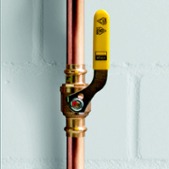Consider a case where you are building two new homes that have a similar layout and are in the same climate. Both of the new homeowners are interested in upgrading to a radiant heating system — an increasingly popular choice. Do you recommend electric or hydronic radiant heat?
The reality is that the answer for each home may not be the same. That’s because while designed with the same end goal in mind, these two radiant systems operate quite differently, and thus are better suited to certain situations based on a homeowner’s needs.
Two Radiant Systems, Two Methods of Operation
Electric Radiant Heat
Electric radiant heating relies on heat-conducting plastic mats that include coils and they are placed under the floor-level. The coils in the mats are warmed by electric currents to heat the floor and distribute radiant heat. Essentially, the way electric radiant heat functions is quite similar to how an electric blanket works.
Hydronic Radiant Heat
Hydronic radiant heating is sometimes simply referred to as a “water-based system.” This type of system relies on a circulating pump to move hot water through PEX tubing and back to the heat source. The heat from the water radiates into the room to create a temperature that is both comfortable and consistent.
How This Ties Back into Applications
Let’s circle back to the initial example we provided. Perhaps one homeowner only wants to heat the bathrooms in their home, while the other wants to heat the whole interior.
In general, electric radiant heating systems are suitable for smaller jobs like individual rooms. That’s because when used on a larger scale, electric radiant heat is bound to result in costly energy bills from month-to-month.
(While we’ve used the example of new construction, electric radiant heating systems are also a good option for smaller retrofit projects. Contractors can lay down the electric mats and plug them into an outlet without having to tap into existing hydronics.)
If we’re talking about a home with radiant heat throughout, a hydronic system is a clear winner. Hydronic radiant heating systems are not only more cost-effective for larger projects, but they also offer more flexibility in terms of design and layout. This is due in part to the flexible nature of PEX tubing, as well as the various installation methods that are available — from wood panels that go above the sub-floor to aluminum panels that go underneath the sub-floor.
Does a hydronic radiant system feel like a good fit for projects in your pipeline? If so, we encourage you to learn more about the hydronic radiant solutions that Viega provides.









